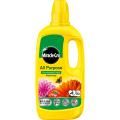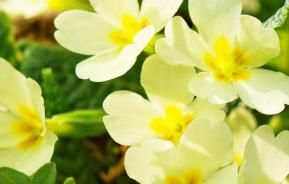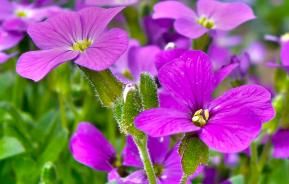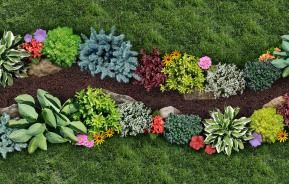Petunias are one of our most popular summer bedding plants, flowering throughout summer until the first severe frosts of autumn. Their mass of flowers bring lots of great colour to gardens.
The compact, bushy varieties are perfect for planting in beds and borders and the trailing types brighten up hanging baskets and for flowing down the edges of containers.
There is great variety in petunia flowers: a wide range of colours; both single and double blooms; smooth or ruffled petals; solid single, striped, veined or picotee-edged colours; and even fragrance. Recent breeding has also removed the scourge of old petunia varieties – turning to mush in a wet summer.
Petunias are perennial, although most bedding types are grown as annuals from seed each year. The trailing varieties, such as Surfinias, are perennial and are grown from cuttings or new plants.
How to grow petunias
Cultivating petunias
Petunias prefer to be grown in full sun, although during hot, sunny summers they will tolerate light shade. They grow best in a fertile, moist but well-drained soil. Dig in plenty of organic matter – such as garden compost, well-rotted manure or other soil improver – especially in very well-drained sandy soils to hold moisture.
Petunia varieties
Bedding varieties are either grandifloras with larger flowers or multifloras with smaller flowers that hold up better in the rain.
Spreading or trailing petunias include Surfinia, Wave, Tumbelina, Supertunia and Cascadia series.
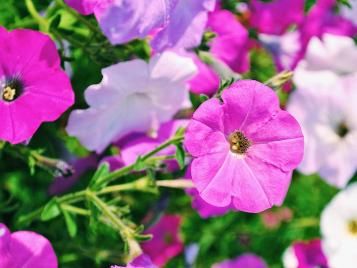
Sowing petunias
The annual or bedding petunias can be grown from seed sown indoors with warmth in spring in cell trays, seed trays or small pots at a temperature of 18-24°C (65-75°F).
When large enough to handle, prick out plants individually into cell trays or small pots and grow on at a temperature of 50-65°F (10-15°C) in good light.
Gradually acclimatise the plants to outdoor conditions for 7 to 10 days before planting outdoors when all risk of frost has passed.
If you don’t have the facilities to grow them from seed, young petunia seedlings are available from garden centres and mail order suppliers in late winter/early spring.
Planting petunias
Petunias are planted out in May/June after the danger of frost has passed.
Dig a good sized planting hole, big enough to easily accommodate the rootball. Add a layer of organic matter – such as compost or planting compost – to the base of the hole and fork it in.
Place the rootball in the planting hole and adjust the planting depth so that it is planted at the same depth as it was originally growing (except hardy fuchsias) and the top of the roots are level with the soil surface. Mix in more organic matter with the excavated soil and fill in the planting hole. Apply a granular general feed over the soil and water in well. Applying a 5-7.5cm (2-3in) deep mulch of well-rotted garden compost or similar over the soil will help maintain soil moisture and keep down weeds.If you have a warm greenhouse, you can plant up containers and baskets in spring and grow on the plants, ready to place outside in late May/early June. This way you’ll have flowers earlier in the summer.
Where to plant petunias
Flower borders and beds, patios, containers, city and courtyard gardens, cottage and informal gardens.
How to care for petunias
Keep the soil moist by watering regularly during prolonged dry periods in summer. Plants in containers will need regular, possibly daily watering – the aim being to keep the compost evenly moist. But don’t overwater, as too much water will cause the plants to become leggy with few flowers.
Feed regularly throughout summer with a liquid plant food to ensure a continuous supply of flowers. A high potash liquid plant food will encourage more, better blooms over a long flowering period until the first autumn frosts.
Removing faded flowers and any developing seed pods will prolong the display. Straggly plants can be cut back quite hard and then fed with a liquid plant food to produce fresh new growth and a profusion of flowers.
In the autumn, once damaged by frosts, bedding petunias are best dug up and composted.
Overwintering petunias
Perennial, trailing varieties can be cut back hard in autumn, tidied up to remove dead or damaged growth and carefully lifted. Pot them up in pots just big enough to take the rootball and some fresh potting compost around the sides, and overwinter in a light, frost-free place – preferably a greenhouse or cool conservatory.
Propagating perennial petunias
Perennial, trailing varieties can be propagated from cuttings taken in March/April from overwintered plants or in August/early September.
Choose strong, healthy young stems that aren’t flowering. If you can’t find suitable growth, cut back hard one or two stems at the back of the plants to encourage strong regrowth. Take cuttings 7.5-10cm (3-4in) long, cutting just below a leaf joint, or node. Remove the leaves from the lower two-thirds of the stem and insert five or six cuttings in pots of gritty, cuttings compost to the base of the lowest leaves. Place the pots in a plastic bag or in a propagator and place somewhere in good light, but out of direct sunlight, to root.
The cuttings should have rooted in 2 to 3 weeks, when they can be potted up individually and grown on.
| Flowering season(s) | Summer, Autumn |
|---|---|
| Foliage season(s) | Spring, Summer, Autumn, Winter |
| Sunlight | Full sun |
| Soil type | Clay, Loamy, Sandy |
| Soil pH | Neutral |
| Soil moisture | Moist but well-drained |
| Ultimate height | Up to 30cm (12in) depending on variety |
| Ultimate spread | Up to 1.5m (5ft) depending on variety |
| Time to ultimate height | 4-6 months |

